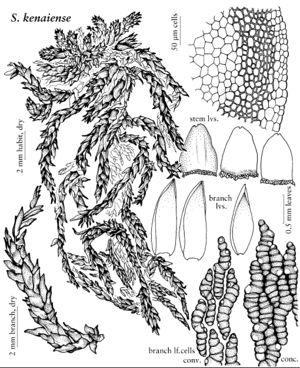Difference between revisions of "Sphagnum kenaiense"
Sida 22: 961, figs. 7–13. 2006,.
FNA>Volume Importer |
imported>Volume Importer |
||
| (5 intermediate revisions by 2 users not shown) | |||
| Line 29: | Line 29: | ||
-->{{#Taxon: | -->{{#Taxon: | ||
name=Sphagnum kenaiense | name=Sphagnum kenaiense | ||
| − | |||
|authority=R. E. Andrus | |authority=R. E. Andrus | ||
|rank=species | |rank=species | ||
| Line 43: | Line 42: | ||
|publication year= | |publication year= | ||
|special status= | |special status= | ||
| − | |source xml=https:// | + | |source xml=https://bitbucket.org/aafc-mbb/fna-data-curation/src/2e0870ddd59836b60bcf96646a41e87ea5a5943a/coarse_grained_fna_xml/V27/V27_45.xml |
|genus=Sphagnum | |genus=Sphagnum | ||
|section=Sphagnum sect. Cuspidata | |section=Sphagnum sect. Cuspidata | ||
Latest revision as of 21:26, 5 November 2020
Plants small and weak-stemmed; grows sprawling in lawns; pale brown to golden brown; capitulum flat-topped and only weakly 5-radiate. Stems pale yellow; stem cortex moderately well-differentiated but not much enlarged. Stem leaves appressed to stem or somewhat spreading; lingulate, ovate, to triangular; equal to or less than 0.9 mm; apex obtuse and often erose to lacerate. Branches with leaves unranked to 5-ranked, leaves not much elongated at distal branch tip. Branch fascicles with 2 spreading and 2–3 pendent branches. Branch leaves ovate, 1.1–1.3 mm long, stiff, weakly undulate and slightly recurved when dry; hyaline cells in mid region quite short and broad, 3.3–2.5:1, in basal 1/2 of leaf on convex surface often with 1 large pore apically and/or up to 6 free pores, in apical region often with pseudopores along the cell margins; on concave surface with large round wall-thinnings in the cell ends and angles (these sometimes faint or absent); chlorophyllose cells triangular in transverse section and typically well-enclosed on concave surface. Sexuality unknown.
Habitat: Lawns and hollows, typically in sedgey weakly minerotrophic fens
Elevation: low to moderate elevations
Discussion
Selected References
None.

